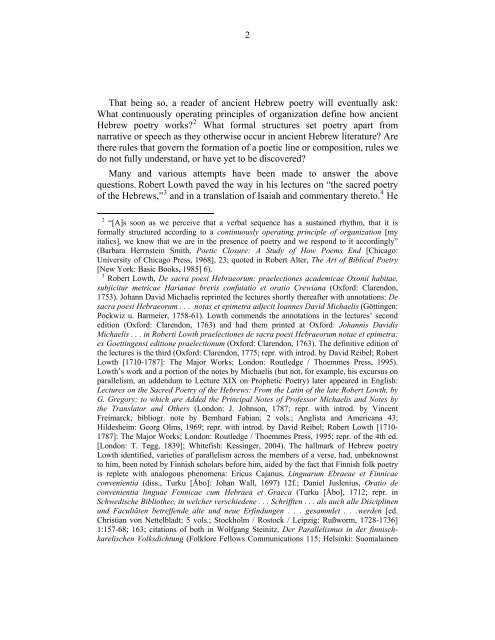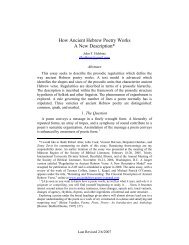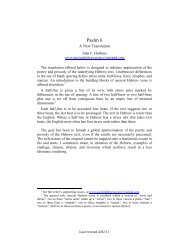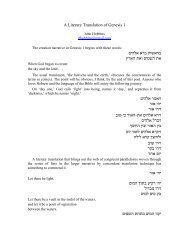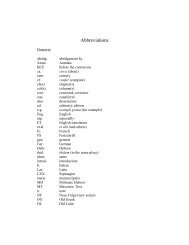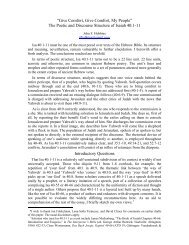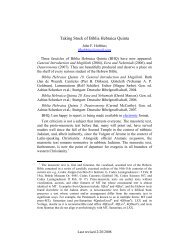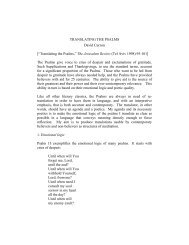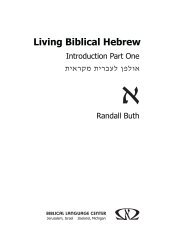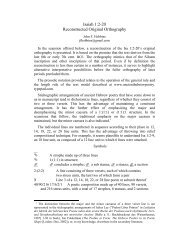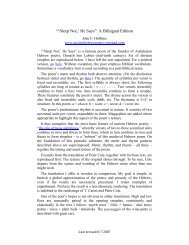Here - Ancient Hebrew Poetry - Typepad
Here - Ancient Hebrew Poetry - Typepad
Here - Ancient Hebrew Poetry - Typepad
- No tags were found...
You also want an ePaper? Increase the reach of your titles
YUMPU automatically turns print PDFs into web optimized ePapers that Google loves.
2That being so, a reader of ancient <strong>Hebrew</strong> poetry will eventually ask:What continuously operating principles of organization define how ancient<strong>Hebrew</strong> poetry works? 2 What formal structures set poetry apart fromnarrative or speech as they otherwise occur in ancient <strong>Hebrew</strong> literature? Arethere rules that govern the formation of a poetic line or composition, rules wedo not fully understand, or have yet to be discovered?Many and various attempts have been made to answer the abovequestions. Robert Lowth paved the way in his lectures on “the sacred poetryof the <strong>Hebrew</strong>s,” 3 and in a translation of Isaiah and commentary thereto. 4 He2 “[A]s soon as we perceive that a verbal sequence has a sustained rhythm, that it isformally structured according to a continuously operating principle of organization [myitalics], we know that we are in the presence of poetry and we respond to it accordingly”(Barbara Herrnstein Smith, Poetic Closure: A Study of How Poems End [Chicago:University of Chicago Press, 1968], 23; quoted in Robert Alter, The Art of Biblical <strong>Poetry</strong>[New York: Basic Books, 1985] 6).3 Robert Lowth, De sacra poesi Hebraeorum: praelectiones academicae Oxonii habitae,subjicitur metricae Harianae brevis confutatio et oratio Crewiana (Oxford: Clarendon,1753). Johann David Michaelis reprinted the lectures shortly thereafter with annotations: Desacra poesi Hebraeorum . . . notas et epimetra adjecit Ioannes David Michaelis (Göttingen:Pockwiz u. Barmeier, 1758-61). Lowth commends the annotations in the lectures’ secondedition (Oxford: Clarendon, 1763) and had them printed at Oxford: Johannis DavidisMichaelis . . . in Roberti Lowth praelectiones de sacra poesi Hebraeorum notae et epimetra:ex Goettingensi editione praelectionum (Oxford: Clarendon, 1763). The definitive edition ofthe lectures is the third (Oxford: Clarendon, 1775; repr. with introd. by David Reibel; RobertLowth [1710-1787]: The Major Works; London: Routledge / Thoemmes Press, 1995).Lowth’s work and a portion of the notes by Michaelis (but not, for example, his excursus onparallelism, an addendum to Lecture XIX on Prophetic <strong>Poetry</strong>) later appeared in English:Lectures on the Sacred <strong>Poetry</strong> of the <strong>Hebrew</strong>s: From the Latin of the late Robert Lowth, byG. Gregory; to which are Added the Principal Notes of Professor Michaelis and Notes bythe Translator and Others (London: J. Johnson, 1787; repr. with introd. by VincentFreimarck; bibliogr. note by Bernhard Fabian; 2 vols.; Anglista and Americana 43;Hildesheim: Georg Olms, 1969; repr. with introd. by David Reibel; Robert Lowth [1710-1787]: The Major Works; London: Routledge / Thoemmes Press, 1995; repr. of the 4th ed.[London: T. Tegg, 1839]; Whitefish: Kessinger, 2004). The hallmark of <strong>Hebrew</strong> poetryLowth identified, varieties of parallelism across the members of a verse, had, unbeknownstto him, been noted by Finnish scholars before him, aided by the fact that Finnish folk poetryis replete with analogous phenomena: Ericus Cajanus, Linguarum Ebraeae et Finnicaeconvenientia (diss., Turku [Åbo]: Johan Wall, 1697) 12f.; Daniel Juslenius, Oratio deconvenientia linguae Fennicae cum Hebraea et Graeca (Turku [Åbo], 1712; repr. inSchwedische Bibliothec, in welcher verschiedene . . . Schrifften . . . als auch alle Disciplinenund Facultäten betreffende alte und neue Erfindungen . . . gesammlet . . .werden [ed.Christian von Nettelbladt; 5 vols.; Stockholm / Rostock / Leipzig: Rußworm, 1728-1736]1:157-68; 163; citations of both in Wolfgang Steinitz, Der Parallelismus in der finnischkarelischenVolksdichtung (Folklore Fellows Communications 115; Helsinki: Suomalainen


